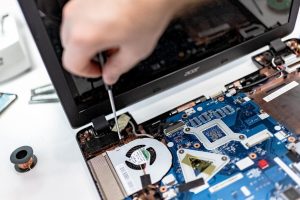11 Hacks to Make Your Laptop Run Faster
How often do you find yourself in situations where your laptop is running slow or takes ages to boot up? Maybe it’s frozen or unresponsive. Maybe it’s overheating and making your lap burn. Or maybe it’s just getting bogged down by all the apps and programs that are open at once.
If you’re like me, you probably spend a good amount of time in front of your laptop. And if you’re also like me, you probably have a lot of tabs open at any given time.
That’s cool and all—but it can also be pretty inefficient. That’s because the more tabs you have open, the slower your computer is going to run. It takes longer for it to load webpages and apps, and it uses more battery power.
No matter what kind of problem you’re having, one thing is certain—you could use some tips on how to make your laptop more efficient and run faster. I’ve got a few tips and tricks that will help you get the most out of your machine—whether that means saving battery life or making sure it’s running at its peak performance.
How to Speed Up Your Laptop
This article will help you speed up your computer.
A slow computer can be frustrating, but it doesn’t have to be that way. There are a number of things you can do to make your laptop run faster, and we’ve rounded them up for you here.
The first thing you should do when looking for ways to speed up your laptop is to check out what programs are running on your machine. You can usually find this information by clicking on the taskbar icon at the bottom of your screen, or by right-clicking on the taskbar and selecting “Task Manager” from the drop-down menu that appears. The Task Manager will show you which applications are currently running. If there are any programs that aren’t currently being used, consider closing them so they don’t take up system resources unnecessarily.
You should also make sure that your laptop is running as efficiently as possible by changing some settings in Windows 10’s power options: Open Settings in Windows 10 by pressing Windows Key + I on your keyboard; Go to System > Power & Sleep; Click “Additional power settings” under Related Settings; Select “Change plan.
Here are other changes you can make on your laptop to make it more efficient.
-
Free Up Space on Your Hard Drive
Your computer runs more smoothly when it doesn’t have to work so hard to find room for all the data you’ve got stored on your hard drive. While you’ll want to wait until you’ve cleared out a bunch of space before re-downloading your apps and other files, there are some simple things you can do right now to make sure that your laptop is running as smoothly as possible.
First, make sure that you have enough space on your hard drive for all the programs and files you need. You can check this by opening up the “Disk Management” tool in Windows or MacOS (usually under “Administrative Tools” in your system settings), and then looking at the size of each partition on your computer. If one of them is smaller than 30% full, consider freeing up some space there.
-
Clean Temporary Files
A thing you can do to speed up your laptop is clean temporary files. Temporary files are files that are created to help you perform certain tasks. They may be necessary for your computer to function properly, but they take up space in your hard drive and slow down the performance of your system.
To clean temporary files on a Windows machine, click the Start button and then click Computer. Double-click C: (or whatever letter corresponds to your operating system), then open up the Temp folder. Here you’ll find a number of folders with names like “WinSxS,” “Microsoft,” and “Application.” Select all the folders in this folder except for the one called “Software Distribution,” right-click each folder individually and choose Delete.
On a Mac, open Finder and click on Applications > Utilities > Terminal. Type “rm -rf /private/var/folders/<space>/<folder name>/” (without quotes), where <space> is a space character and <folder name> is the name of any folder in /private/var/folders/. Press Enter, then type “rm -rf /private/var/folders/” again without quotes (this should be one line). Then press Enter again followed by “sudo rm
-
Disable Startup Programs
If you’re looking for a quick way to speed up your laptop, try disabling startup programs. You can do this by opening the Task Manager, which is usually located in the Start menu under Accessories. In the Task Manager window, click on the Startup tab and uncheck any programs you don’t need running when you start your computer.
You can also achieve these by following the steps below:
1. Click “Start” and type msconfig in the search box to open the System Configuration window. If you don’t see this option, click “Control Panel” and then “System & Security.”
2. Click “Startup.” You’ll see a list of programs that are set to start automatically every time your computer starts up. To disable one, click it and then click “Disable” at the bottom of the screen. You’ll have to restart your computer for changes to take effect.
-
Check for Malware and Spyware
Computers run more slowly for a variety of reasons, but one of the most common is malware and spyware. These are programs that can hijack your computer and make it work much slower than it should, so if your laptop seems to be running slowly, check for those programs first.
You can do this by running an anti-virus program like Malware Bytes or Spybot Search & Destroy. If you find anything suspicious on there, run the program and let it remove what it finds. You may have to reboot your computer after doing so.
-
Delete Internet Browsing History and Cookies
One of the best ways to speed up your laptop is to delete your internet browsing history and cookies. This will not only make your browser perform faster, but it will also help you be more secure and private.
To do this, follow these steps:
* Open your browser’s settings menu by clicking on the gear icon in the top right corner of your browser window.
* Click on “Privacy” or “History” to find where you can clear your data. You may have to click through several pages of settings before you find it!
* Once you’re in the correct place, click “Clear Browsing Data.”
* Choose what kind of data you want to clear (such as the last hour or last day). Then hit “Clear Browsing Data.”
Now, when you navigate back to that site, you’ll see that it all looks brand new!
-
Avoid Adding More Software Programs
Adding new programs can make your computer run slower and cause it to crash more often. If you want to avoid this, try uninstalling any programs you don’t use anymore.
The more programs you have running on your computer, the less memory and processing power it has available for each individual program. This means that each program will run slower.
If you’re trying to speed up your laptop and you want to add some new programs, it’s best to uninstall some old ones first. You can also look into ways of improving performance by disabling certain features or reducing how much RAM gets used by certain programs.

-
Update your Operating System
One of the easiest ways to speed up your laptop is to update your operating system. This is because most of the time, updates include improvements that make the computer run faster.
To update your operating system, go to Settings and then click on “Update & Security.” Click on “Windows Update” and then choose “Check for Updates.” You can also check for updates manually by clicking on “Check for Updates” in Windows Update.
-
Add more memory (RAM)
Your computer’s processor can only process so much information at any given time. When your computer starts to run slow, it’s usually because there’s too much information for the processor to handle.
The best way to speed up your laptop is to add more memory (RAM). This will allow the processor to access information faster, which helps your computer run faster.
Simply open up the settings menu on your laptop and find the section that allows you to add more memory. Your options will vary depending on the brand of laptop you have, but it’s usually located in either “System” or “Performance.” The amount of RAM available varies from computer to computer, so make sure that you’re adding at least as much as what’s already installed. Make sure your laptop is off and remove the laptop battery before changing or adding RAM.
-
Update Programs
You might be surprised by how much your laptop can slow down if you don’t update your programs and apps.
Updating programs and apps is the single best thing you can do to speed up your laptop.
And it’s free! You can do it right now, while you’re reading this article.
Just go to the app store or program website for the software you use most often. Search for updates, and download them when they pop up in search results.
-
Use a solid-state drive
Your computer is fast. It can do everything you want it to do, and it can run multiple applications at once. But there’s one thing that can make your laptop feel like it’s stuck in molasses: a hard disk drive (HDD).
HDDs are the old-fashioned storage devices that are used by traditional computers. They spin around and store information on spinning platters. HDDs are slower than solid-state drives (SSDs), which store data on flash memory chips instead of spinning platters. SSDs are much faster, but they’re more expensive than HDDs.
If you’re looking to speed up your laptop, there’s one more easy thing you can do: get a solid-state drive (or SSD).
An SSD is a special kind of hard drive that uses flash memory instead of the spinning platters and magnetic read/write heads that traditional hard drives use. The result is that SSDs are much faster than traditional hard drives, because they don’t have to move around to find the data you want.
Replacing your existing hard drive with an SSD will give you one of the biggest performance boosts possible. You might be able to find an old laptop lying around—one with a spinning hard drive—and add in a new SSD as an upgrade!
-
Service your laptop regularly
If you want to speed up your laptop, the first thing you need to do is service it regularly. This means cleaning out the dust and debris that can build up inside your computer over time. The thermo paste on the processor needs also to be replaced to avoid over hitting which slows a laptop down.
Make sure you’re performing regular maintenance on your laptop. It’s best to service it every six months or so. This will help keep it running at its highest potential, so that when you need it to perform at its best, it will!

If you don’t know how to service your laptop yourself or don’t have time for it during the day, consider taking it into a local repair shop. They’ll be able to take care of any issues with your computer that could be slowing it down significantly.
Conclusion
If you have a new laptop, then you may not need to do much. But if you’re like me, and waited 6 months or a year to buy your last laptop, it’s probably getting a little slow. You can speed up virtually any laptop by following the above steps. There are also a lot of programs and apps that can help to speed up your Windows laptop, but with so many options out there, it’s tough to decide which one is best. It’s even harder to tell if your computer is running faster after you install these programs.
In the end, if you’re finding that your slow laptop is hampering your productivity, you may have little choice but to make a big purchase. But in the meantime, there are several smaller steps that you can take that can definitely speed up your current setup. If nothing else, these tips will give you a better idea of whether your computer has simply outgrown its usefulness and it’s time for an upgrade.



